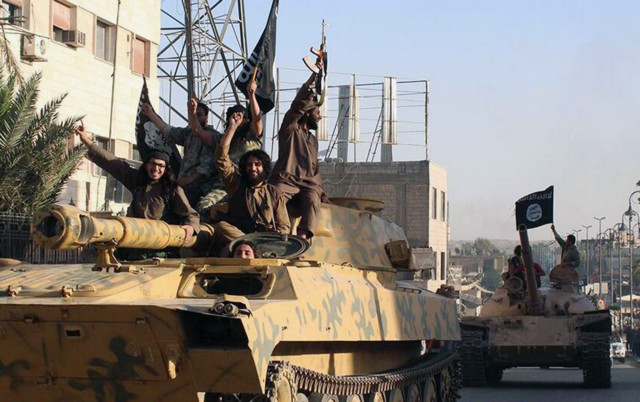
The Islamic State in Iraq and Syria (Isis), which supporters of the extremist project identified as the Islamic State in Iraq and the Levant (Isil) thereby granting it a much wider geographic spread that would include Jordan, Palestine and Lebanon, gained significant momentum during the past few weeks. Emboldened by his successes, Abu Bakr Al Baghdadi solidified his leadership over Isis, announced the establishment of a caliphate and, naturally, designated himself as the new ruler of the Islamic Ummah (community).
The exercise was the first in the 21st Century and was bound to lead to serious confrontations as a Lebanese television network boasted that Isis appointed an “emir” over Lebanon even if the LBC channel could not provide any evidence to confirm this assertion. It would not be long before similar emirs emerged in Syria, Jordan, Palestine and elsewhere, which reminded one of ancient satrapies in the Persian Empire — but that continued the tradition of appointing governors under the Sassanid and even Hellenic empires — who ruled as surrogates in the name of larger powers.
Over the weekend, the unexceptional Abu Bakr Al Baghdadi announced that his caliphate would restore order, which was akin to a declaration of war not only against the post-Westphalia nation-state system that resulted in the independence of 23 Arab States, but also against challenged extremist movements like the so-called Al Qaida. Few can deny that the Isis attempt was little more than a consolidation effort, especially after one Abu Mohammad Al Adnani, an alleged “spokesman” for the group, urged those living in areas under the group’s control to swear allegiance to Al Baghdadi. The “restoration of the caliphate” was apparently made by a Shura Council, Al Adnani affirmed, without any identification of its members or their qualifications to reach such a momentous decision.
Indeed, past failures attributed to the fictitious Al Qaida may well have encouraged “Isisites” [both self-appointed leaders as well as blind followers] to make a bid for the extremist agenda, although it was too early to determine whether Isis was the final repository of such goals. To be sure, the caliphate remained the ultimate objective in historical terms but it was nearly impossible to conclude whether the world’s Sunni populations were ready to jettison their bayahs (oaths of allegiance) from existing rulers, and to grant their allegiances to Al Baghdadi and men of his ilk.
Of course, it was easy to assume that Isis succeeded because the Iraqi Armed Forces melted in front of a few thousand rag-tag elements, though that short-term collapse was more the result of Prime Minister Nouri Al Maliki’s poor leadership skills than Al Baghdadi’s prowess. Be that as it may, the declaration of a caliphate cannot and should not be ignored because it threatens all 23 independent Arab states, even if the principal battlefield was concentrated in Iraq for the time being.
Caught in a premier sectarian inferno — Sunni versus Shiite extremists volunteering to butcher each other on command — Iraqis confronted two terrifying options. Isis on one side and Asaib Ahl Al Haq, a powerful Shiite militia under the direct control of Iranian officers, on the other, that, and this was worth noting with grave concern, seldom elicited any negative remarks from Prime Minister Al Maliki. It was as if Asaib was untouchable in Baghdad even if its actions encouraged Isis to reciprocate and drag the country into yet another civil war.
For Al Baghdadi and his crack Isisite team to succeed, however, it was not enough to defeat Al Maliki, the Asaib or even a variety of elements supported by the Iranians directly or even indirectly. Rather, Al Baghdadi faces the following challenges:
First, would Muslims in general and Arabs in particular, accept the very idea of a caliph since doing so necessitated unanimity within the realm?
Second, would harsh interpretations of Sharia [Islamic] law, which re-evaluated established ideological and theological norms that were settled over centuries, be tolerated by the vast majority of Muslims who are moderate and practical believers?
Third, how could Muslim theologians and political leaders tolerate the killing of large numbers of opposition forces, whether they happened to be deviant Sunnis or Shiites?
Fourth, how would Arab monarchs, presidents, and prime ministers co-exist with caliph Al Baghdadi?
Fifth, where was the urgency that these officials presumably felt since no one called for a Summit to coordinate anti-Isis efforts?
Finally, and beyond Al Baghdadi’s cult of personality theatrics, how long was Isis likely to rule over areas under its control once financial and material backers reassessed their putative commitments?
How Al Baghdadi understood, and responded to, these challenges and, equally important, how Arab leaders perceived “Isisite” goals, were neither easy to unravel nor draft policy rejoinders. Most Arab rulers were perplexed that such phenomena would occur in their midst in the 21st Century though, mercifully, very few Muslims and fewer Arabs supported extremist “caliphs”. What most desired was freedom and the opportunities to create wealth. The rest was passing theatre.
Dr Joseph A. Kechichian is the author of Legal and Political Reforms in Saudi Arabia (London: Routledge, 2013).











